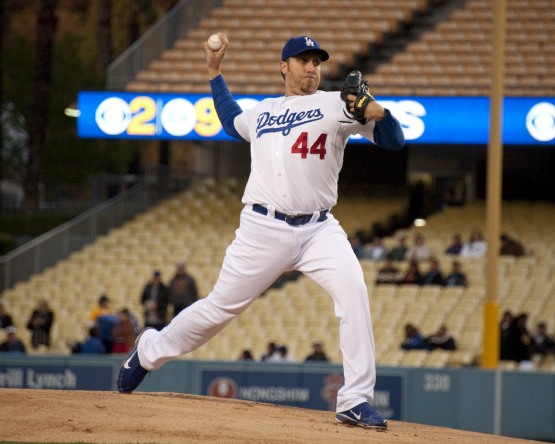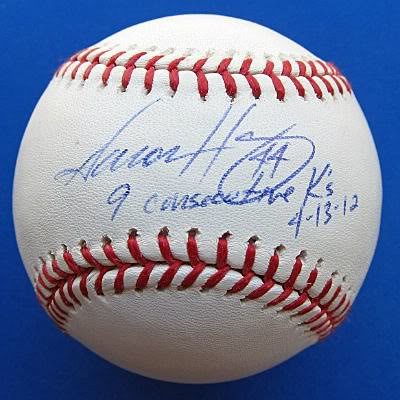The date was April 13, 2012. It was a Friday night – yes, Friday the 13th. The Dodgers were playing those pesky San Diego Padres at Dodger Stadium – the same San Diego Padres who always seem to be involved in unusual games with the Dodgers. (Who can forget that historic four-consecutive four-home-run game – among others?).
According to MLB.com’s Gameday there were only 31,601 on hand at the Ravine on that rain-threatening evening to watch Dodgers right-hander Aaron Harang take on Padres left-hander Clayton Richard. It was an early-season game the wasn’t a marquee game by any stretch of the imagination. In fact, the then 34-year-old Harang was in his 10th MLB season (and his only one with the Dodgers) and Richard, then a 28-year-old in his fifth major league season who would go on to have the worst seasons of his career. (He gave up more hits [228] and more home runs [31] than any other pitcher in the majors in 2012).
But this chilly night – this ho-hum, otherwise basically meaningless early-season Friday the 13th game at baseball’s third-oldest ballpark – belonged to Harang, who would go on to notch his place in baseball immortality … well, at least Dodgers immortality. No, Harang didn’t throw a perfect game or even a no-hitter, nor did he strike out more than 21 batters to break one of baseball’s most coveted pitching records. But what he did do – after allowing a single to Padres center fielder Cameron Maybin to lead off the game – was strike out the next nine consecutive Padres batters he faced. No really … Aaron Harang – the Dodgers number-four starter in a rotation that consisted of Clayton Kershaw, Chad Billingsley, Chris Capuano, Harang and Ted Lilly – actually did this.

Harang’s nine consecutive strikeouts on April 13, 2012 set a new Dodgers franchise record.
(Photo credit – Jon SooHoo)
To be fair, the lanky 6′-7″ – 260-pound extremely soft-spoken San Diego, California native finished his career with a very respectable 1,842 strikeouts and 2.12 K/BB ratio. In fact, while with the Cincinnati Reds in 2007 Harang posted an MLB-best K/BB ratio of 4.19 and finished fourth in the 2007 NL Cy Young award voting.
After Maybin’s leadoff line drive single to Dodgers center fielder Matt Kemp (oh the irony), 30 of Harang’s next 47 pitches were strikes. But his next one – his 48th pitch of the night (also a strike) – just cleared the wall in left field for a solo opposite-field home run to end Harang’s franchise-record-setting nine consecutive strikeouts.
Who was the Padres batter that prevented Aaron Harang for tying the MLB record of 10 consecutive strikeouts in a game set by New York Mets Hall of Fame right-hander Tom Seaver on April 22, 1970?
It was light-hitting, left-handed batting Padres center fielder Will Venable who, on Tuesday, signed a one-year contract with the Dodgers.
Go figure.
The following day I spotted Harang shagging fly balls in left field during batting practice. At one point he neared the left field wall – near the exact spot where Venable’s home run had just cleared the wall the night before – and I asked him if he would be so kind as to sign a baseball for me indicating his remarkable and historic accomplishment, to which he generously agreed. As he was signing the ball, I asked him to please include the date and reminded him that it was April 13, 2012. Upon saying this I noticed Aaron chuckle and he said to me “I better not forget the date, my wife would kill me. It’s our wedding anniversary.”

Who knew?




 June 16th, 2016 at 10:45 am
June 16th, 2016 at 10:45 am  by Ron Cervenka
by Ron Cervenka  Posted in
Posted in 

There is always a story connected to almost everything that happens in baseball. Who would have guessed that Venable would have become a Dodger? Not bad that you remembered that.
When I saw the title and picture I initially thought that Harang had been signed by the Dodgers. Aaron’s a great guy but I like the story better as it unfolded.
I’m not for certain, that this might be the reason I held Venable so high in my regard, as a hitter, but how did he hit against the the Dodgers in his career?